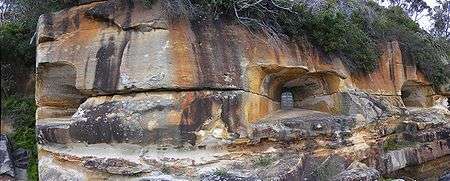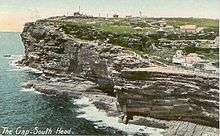Sydney Heads
| Sydney Heads | |
| North Head, South Head, Middle Head, and the Heads | |
| Headlands | |
| The Sydney CBD skyline seen from North Head | |
| Country | Australia |
|---|---|
| State | New South Wales |
| Region | Metropolitan Sydney |
| Location | Port Jackson |
| - coordinates | 33°50′12″S 151°16′52″E / 33.836772°S 151.281052°ECoordinates: 33°50′12″S 151°16′52″E / 33.836772°S 151.281052°E |
| Founded | 4 April 1975[1] |
| Management | Sydney Harbour National Park |
| Wikimedia Commons: Sydney Heads | |
The Sydney Heads (also simply known as the Heads) are a series of headlands that form the two-kilometre-wide (one-point-two-mile) entrance to Sydney Harbour in Sydney, New South Wales, Australia. North Head and Quarantine Head are to the north; South Head and Dunbar Head are to the south; and Middle Head, Georges Head, and Chowder Head are to the west and within the harbour. The Heads are contained within the Sydney Harbour National Park.
Some features located on the heads are listed on the Australian Heritage Database;[2] such as the Hornby Lighthouse, located on South Head, Australia's third-oldest lighthouse; and Macquarie Lighthouse, Australia's first lighthouse, located three kilometres (one point nine miles) to the south on Dunbar Head.
North Head

North Head is a headland south-east of the suburb of Manly. It is part of Sydney Harbour National Park. The headland is a promontory of sandstone and is 3.85 square kilometres (1.49 sq mi) in area.
Sydney Quarantine station
The heritage-listed[2] Sydney Quarantine station is located on North Head and is one of the few still-existing facilities that once operated in each state of Australia until the 1980s. From 1828, Spring Cove, on the western side of North Head, was used to quarantine new arrivals to Sydney to minimise the spread of communicable diseases such as smallpox and whooping cough. In 1832, the whole area of North Head was set aside for a quarantine station.[2] A permanent quarantine facility was set up in 1837 and continued to operate until 1984.
The site contains the remnants of Colonial (Colony of New South Wales) period buildings and equipment which were the best available means of combating major contagious diseases and hygiene-related conditions brought to the colony by ship. Soon after Federation the Commonwealth Government initiated a major building and infrastructure program which also remains largely intact today. This program included similar, but smaller, quarantine stations around Australian ports, of which North Head is the only remaining example. This site dealt with major shipping-related epidemic outbreaks which took place up until the 1940s. As such, the quarantine complex represents on of the most complete collection of buildings, equipment and a setting showing how life was lived among the struggles and successes in public health of Australia's past.
After 1945 the requirements for quarantine changed to small air-travel family groups serving periods of observation due to a lack of required inoculations. To these groups the site provided a scenic haven in a rustic historic setting. Many of the inscriptions on the local sandstone outcrops record the names and reasons why previous colonial and latter occupants found themselves in such a place. The buildings remain much as they had been in a former age and provided an opportunity for air-travel 'patients' to become acquainted with a unique collection of historic ephemera. In 1970 the then Officer-in-Charge at the station, Herbert Lavaring, was awarded a Queens Birthday Honors Award (BEM) for his efforts in keeping the historic site preserved while also creating a practical, enriching environment for patients and the public to enjoy. The steam-powered laundry and fumigation autoclaves are a unique collection of industrial technology from the past; they provide an insight into the technology required to deal with combating hygiene-related and other readily communicable diseases in an age before antibiotics and vaccinations.
In 1975, Vietnamese refugees were housed there, and in 1975 and 1976, Cyclone Tracy victims from Darwin, Northern Territory were also housed there.[2] The station was finally closed in 1984 and the management of the site passed to the New South Wales National Parks and Wildlife Service. The facility is now a tourist facility and part of the former Quarantine Station may be leased for accommodation.[3]
The nearby Inner North Head clifftops have many inscriptions from the quarantine period as well as the remnants of 1940s coastal defenses in the form of two gun sites, a range-sighting post, four ammunition storage bunkers and a fortified outhouse. This location has been the site of erosion and geo-technical instability. It may be subject to natural rockfalls as the erosion process continues.
Defence facilities
From 1934, defence facilities were installed on the headland but were wound down in 1945. From 1953, there was a School of Artillery, which used the former defence facilities. The harbour reserve was established in 1979. The School of Artillery relocated to Puckapunyal army base in Victoria in 1998, but an artillery museum remains on the headland. In 2001, the site was passed to the Sydney Harbour Federation Trust for management.[4] In 2010 the artillery collection was moved to the Army Museum Bandiana[5] in Bandiana, Victoria; the Trust plans to establish an exhibition on the defence of Sydney on the site.[6] There are still remains of the gun emplacements and artificial tunnels used by the army, many of which can be seen by the public or on guided tours.[7][8]
Australian Institute of Police Management
Also located on North Head is the Australian Institute of Police Management, housed in a secure compound which has been the 'Seamen's Quarters' of the quarantine station, a place where sailors with acquired STIs were treated and securely confined behind high sandstone walls (prior to the development of modern antibiotics).
South Head

South Head is a headland, part of Sydney Harbour National Park, to the north of the suburb of Watsons Bay.
A twenty-minute foreshore walk on the South Head Heritage Trail offers dramatic views of Middle Head, Manly, North Head and the Tasman Sea. Starting at the delightful Camp Cove Beach, an 1870s cobblestone path leads first to Lady Bay (also known as Lady Jane) Beach, one of three in Sydney where nude bathing is lawful. It then loops around the headland, passing Hornby Lighthouse, its lightkeepers' cottages, and several gun emplacements from the end of the 19th century.
HMAS Watson, the Royal Australian Navy training base, is also located at South Head.
Middle Head

Middle Head is a headland between North Head and South Head, beside Middle Harbour. It is part of Sydney Harbour National Park.
Middle Head has an extensive network of defence fortifications and tunnels, including the Middle Head Fortifications, the Georges Head Battery and the Lower Georges Heights Commanding Position and other forts located around Sydney Harbour. The fortifications feature "Tiger Cages", where the military trained soldiers by simulating prisoner of war conditions in Vietnam.
HMAS Penguin is located at Middle Harbour.
Gallery
 North Head and South Head
North Head and South Head Aerial view of North Head
Aerial view of North Head- Middle Head, Mosman
 View of Sydney from South Head
View of Sydney from South Head Fortifications on Middle Head
Fortifications on Middle Head
See also
- Geography of Sydney
- Bradleys Head
- Clark Island
- Cockatoo Island
- Dobroyd Head
- Goat Island
- Rodd Island
- Shark Island
References
- ↑ "Sydney Harbour National Park: Park management". Office of Environment and Heritage. Government of New South Wales. Retrieved 3 October 2014.
- 1 2 3 4 "North Head - Sydney, North Head Scenic Dr, Manly, NSW, Australia". Australian Heritage Database. Department of the Environment and Energy, Australian Government. 2000. Retrieved 23 July 2017.
- ↑ "Q Station". New South Wales National Parks and Wildlife Service. Office of Environment and Heritage, Government of New South Wales. Retrieved 23 July 2017.
- ↑ "Former School of Artillery, North Head". Sydney Harbour Federation Trust. Archived from the original on 19 February 2006. Retrieved 18 April 2006.
- ↑ "Army Museum Bandiana". Australian Army. 6 June 2017. Retrieved 23 July 2017.
- ↑ Munro, Kelsey (14 December 2010). "Last rounds for artillery museum at North Head". The Sydney Morning Herald. Retrieved 20 December 2010.
- ↑ "North Head Sanctuary, Manly". Sydney Harbour Federation Trust. Australian Government. Retrieved 23 July 2017.
- ↑ "North Head Sanctuary, Manly" (PDF). Sydney Harbour Federation Trust. Australian Government. Retrieved 23 July 2017.
External links
| Wikimedia Commons has media related to Sydney Heads. |
- Derricourt, Robin (2008). "South Head". Dictionary of Sydney. Retrieved 29 September 2015. [CC-By-SA]
- Derricourt, Robin (2008). "South Head Signal Station". Dictionary of Sydney. Retrieved 11 October 2015. [CC-By-SA]
- Sydney Harbour National Park at the New South Wales National Parks and Wildlife Service